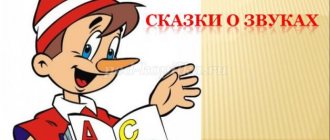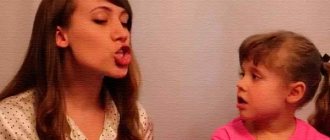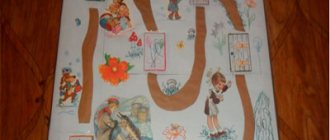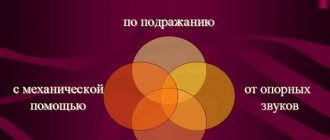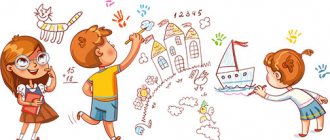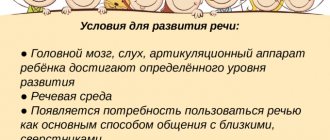Speech therapy manual “Speech”
The purpose of this manual: Using visual aids, increase the effectiveness of speech therapy, generate interest in classes, and create positive motivation in children with speech disorders.
Tasks:
— expansion and enrichment of vocabulary on lexical topics;
— development and improvement of the grammatical structure of speech;
— automation of sounds in speech;
— development of visual gnosis;
— learn to establish logical connections between objects;
— development of phonemic hearing, analysis, synthesis;
— development of coherent speech skills;
- development of spatial concepts, mathematical concepts, perception of color, shape, size;
— development of mental processes (attention, perception, memory, logical thinking);
- development of fine motor skills.
The main job of a teacher-speech therapist is to develop all aspects of speech in children. Often speech therapists are in dire need of didactic and gaming aids, since repeated repetitions of the same material tire not only the child, but also the adult. And then the speech therapist has to figure out how and how to diversify the classes so that the material being worked on does not bore the child and is interesting for him. After all, only positive motivation will contribute to effective work, which will subsequently lead to the desired result.
It is this fact that leads to the search for new methods of work, new universal aids that make it possible to work on the formation of all aspects of a child’s speech.
The “Rechevichok” manual corresponds to a system-active approach, is accessible and safe. The Velcro album helps to work on the development of all aspects of speech, from consolidating correct sound pronunciation to working on the formation of coherent speech. The exercises offered to children help not only eliminate speech disorders, but also contribute to the formation of attention and memory, increase efficiency, activate mental operations, and prepare children for school.
The work uses visual aids in the form of bright and interesting laminated pictures - bases with silhouettes and contour drawings, and pictures on Velcro, stickers and toys, which allow a beneficial effect on the emotional state of children, maintain interest in classes, and form voluntary attention when working with the proposed material.
This manual is intended for different age categories (from 3 years to 7 years). The manual can be used both in individual work with a child and in working with two children at the same time, since it has two and three working surfaces. It is also possible to perform exercises as a team.
“Speech” can be used by educators in classes on speech development and literacy. This fact is very important, because the teacher-speech therapist has the opportunity to recommend consolidation of certain speech skills and help in the selection of visual material (interaction with kindergarten teachers and specialists).
The relevance of this manual lies in the fact that when working with children with speech impairments, it can be very difficult to interest and retain their attention, to awaken interest in the content of the lesson and the learning process as a whole. The use of this game aid facilitates the learning of educational material by children and increases the effectiveness of speech therapy work. The versatility of the manual is expressed in the variety of didactic material that can be used in accordance with the intended purpose. The manual is multifunctional, its use depends on the tasks of the speech therapist in a particular lesson. Pictures from one game can be peeled off and used in other games.
Thanks to the use of Velcro games, the learning process takes place in an accessible and attractive environment for preschool children. The manual can be supplemented as necessary with other games and details. It is convenient to put away parts that were not needed for a particular lesson in the pockets located in the folder. Working with this manual allows you to systematize all the visual material available to the teacher-speech therapist and use it productively in the classroom.
Below are examples of using the “Speech” manual.
Game “Glue the flowers and butterflies yourself”
Goal: learning and consolidation of color, development of thinking, development of visual concentration.
The child needs to find a picture by color and glue it to a house or flower.
You can immediately offer the child games - tasks: “One - many”, “Which picture is the odd one out?”, “Who-what?”, “Make a sentence.”
Game “What fruits and berries do you know?”
Piano for Playschool: application for music lessons
Piano for Playschool (apple, android) is a mobile application that will help your child learn to play the simplest songs and melodies on keyboard instruments. Connecting motor memory and developing fine motor skills of the hands additionally contributes to the development of speech. The application is suitable for children aged 3-6 years and is convenient for parents without musical education.
Together with Piano for Playschool, you can learn speech therapy songs, hone your ability to sing from notes and develop absolute pitch. Such musical classes contribute to the comprehensive psychological and intellectual development of the child and prepare them for learning to play a real instrument.
Unique developmental methodology from Russian teachers
The Zheleznovs are certified musicians-teachers, authors of unique educational activities for preschoolers. They have managed to combine a wealth of teaching experience and a keen understanding of child psychology into a series of audio lessons that is used by parents and educators in a number of countries. Today you can get acquainted with the unique developments of Russian authors to diversify your lessons at home, in kindergarten, or in a development center.
Speech therapy songs are a fun and exciting way to organize a lesson to correct speech disorders. Such songs can also be used for activities with children who do not have difficulties with spoken language. In this case, such exercises allow you to enrich vocabulary, improve diction, and stimulate intellectual development. Speech material is closely related to movement and music, so the Zheleznovs’ method involves the development of vocal skills and active games accompanied by musical accompaniment. The variety of exercises allows you to use them during group or individual classes.
- Advantages of speech therapy music classes:
- fascinating structure of the lesson - playful melodies and song lyrics that suggest movements delight the kids;
- psychological relaxation - in a gaming atmosphere, overcoming speech deficiencies and associated complexes is easier;
- convenient presentation of the material - poetic form, smooth rhythms help children develop correct breathing when pronouncing, teach them to control the pace of conversation, and understand the syllabic structure of words;
- effectiveness – effectiveness in correctional classes and development of musical abilities has been proven in practice;
- versatility - you can study using such audio recordings at home, with a speech therapist, in kindergarten, etc.
One day, Merry Tongue wanted to look at the sun and breathe some fresh air. First the first door opened. Show me how it opened. Yes, it remained open. Don't close the first door until I tell you to. ( Normally, the child can maintain this position
5-6
seconds without twitching, pushing, the corners of the lips are stretched symmetrically.)
Now let’s close the first door. We'll open it again. Let's close. (Repeat this exercise 3-4 times. Normally, the child performs the movement with full amplitude, without attenuation, easily, smoothly, quite quickly.) The doors to the Fun Tongue’s house opened, and he stuck out, but not the whole thing, just the tip. Tongue appeared and hid - it was cold outside.
In the house of the Merry Tongue there is a bed where he sleeps. Look how peacefully he sleeps. ( The tongue lies flat on the floor of the oral cavity, without tubercles, calmly, motionless.
) Let your tongue sleep just as peacefully.
Don't wake him until I tell you to. ( This position is also maintained by the child normally for 5-6 seconds without jolts and twitches, the side edges of the tongue are located symmetrically.
) Let's close the second door first, and then the first.
| Our Tongue is very cheerful, he loves to have fun, jump, sometimes even reaches the ceiling. The ceiling in Tongue's house is called the palate. Let your tongue reach the ceiling and stroke the roof of your mouth. Now let the tongue reach the ceiling and sit there for a while. (The movement should be performed only by the tongue, without auxiliary movements of the lips and lower jaw. The mouth is wide open. Calmly, without twitching, the tongue is held at the top for 5-6 seconds.) Then the Cheerful Tongue went down and again jumped up to the ceiling. Came down. Jumped up... (The exercise is repeated several times. Normally, the child immediately finds the correct position of the tongue, performs movements easily, quickly, with full amplitude.) The tongue jumped up, got tired and went to sleep. Let him rest a little. |
Our Tongue is very cheerful, he loves to have fun, jump, sometimes even reaches the ceiling. The ceiling in Tongue's house is called the palate. Let your tongue reach the ceiling and stroke the roof of your mouth. Now let the tongue reach the ceiling and sit there for a while. (The movement should be performed only by the tongue, without auxiliary movements of the lips and lower jaw. The mouth is wide open. Calmly, without twitching, the tongue is held at the top for 5-6 seconds.) Then the Cheerful Tongue went down and again jumped up to the ceiling. Came down. Jumped up... (The exercise is repeated several times. Normally, the child immediately finds the correct position of the tongue, performs movements easily, quickly, with full amplitude.) The tongue jumped up, got tired and went to sleep. Let him rest a little.
The next day, Tongue decided to check again whether it had become warmer. When all the doors were open, Tongue looked out, looked left, right, up, down ( the child must know the directions of movement of the tongue, immediately find
the desired position, try to complete them in full
), felt that it became colder and went into his house. First one door closed, and then the second. That's the whole tale about the Merry Tongue.
The reason that your child pronounces some sounds incorrectly may also be the insufficient development of his so-called phonemic hearing, that is, the ability to perceive by ear very subtle differences between the sounds of the Russian language, for example, between s
and
c
,
r
and
l
. How to check the state of phonemic hearing in a child? Play a game with him called "Echo". - Remember, you and I were in the forest and heard an echo? Let's play Echo. I will say something, and you repeat everything after me exactly like an echo. Ready? Repeat after me!
Pa-pya-pa. Di-di-dy... etc. Mom washed Mila with soap. (The ability to distinguish between hard and soft consonants is tested)
So, you have tested the child and determined the causes of the sound disorder.
Perhaps he even had a peculiar “bouquet” of all three. What to do next? If your child is already five years old, quickly grab him under the arm and run to the nearest speech therapist. If he is not yet four, take your time; most likely, with age, everything will return to normal. And if your child is between four and five, special exercises will help him cope with “wrong” sounds. If the child cannot repeat correctly due to the fact that he cannot pronounce a certain sound, use this technique: select appropriate pictures, toys or objects and ask the child to show you where Mila is, and where is soap, where is varnish, and where is cancer .
